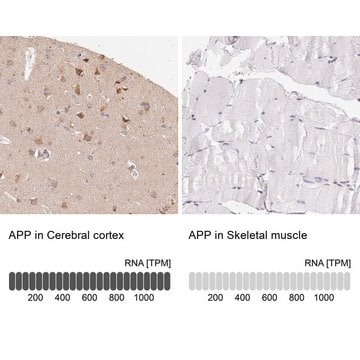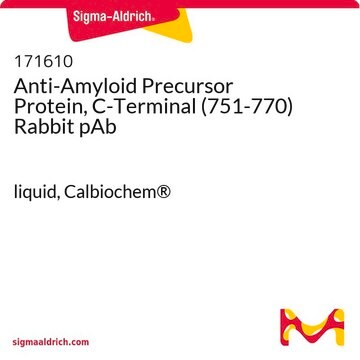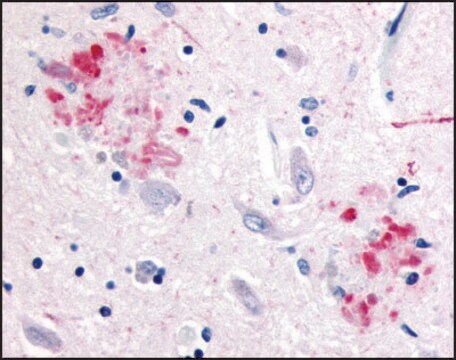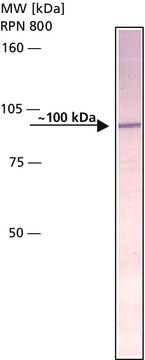MAB343
Anti-APP Antibody, APP 643-695 CT fragment, clone 2.F2.19B4
ascites fluid, clone 2.F2.19B4, Chemicon®
Synonym(s):
APP, Jonas clone
Sign Into View Organizational & Contract Pricing
All Photos(1)
About This Item
UNSPSC Code:
12352203
eCl@ss:
32160702
NACRES:
NA.41
Recommended Products
biological source
mouse
Quality Level
antibody form
ascites fluid
clone
2.F2.19B4, monoclonal
species reactivity
rat, human
manufacturer/tradename
Chemicon®
technique(s)
immunohistochemistry: suitable (paraffin)
western blot: suitable
isotype
IgG1
NCBI accession no.
UniProt accession no.
shipped in
dry ice
target post-translational modification
unmodified
Gene Information
human ... APP(351)
Specificity
Reacts with intact full-length Alzheimer precursor protein (APP) and selectively with the cytoplasmic carboxyl fragment of APP 643-695. Epitope has reportedly been mapped in this paper http://www.impub.co.uk/abs/W386.html
Immunogen
Carboxyl fragment of APP 643-695 / Jonas.
Epitope: APP 643-695 C-terminal fragment
Application
Immunohistochemistry on paraffin sections: 10-20 μg/mL * See protocol below.
Western blot: 10 μg/mL
Optimal working dilutions must be determined by end user.
APPLICATION NOTES FOR MAB343
IMMUNOHISTOCHEMISTRY
1) Prepare paraformaldehyde-fixed paraffin sections. Wash twice for 5 min in xylene to deparaffinize. Wash sections for 5 min in a descending series of alcohol solutions (100%, 96%, 90%, 80%, 70%, 50%, 30%).
2) Wash sections 3 times in distilled water.
3) Wash in TBS (50 mM Tris-HCl, 150 mM NaCl, pH 7.6). To block endogenous peroxidase wash with methanol containing 0.6% H2O2 (v/v) and 10 % horse serum (v/v) for 5 min at room temperature.
4) Wash sections for 5 min in TBS.
5) Incubate sections with MAB343 (diluted in TBS containing 10% horse serum (v/v)) overnight at +4°C or for 2 hours at 37°C in a humid chamber.
6) Wash sections 3 times in TBS for 5 min..
7) Detect with standard secondary antibody detection system (PAP, ABC, etc.).
8) Wash sections in TBS.
9) Embed sections and examine.
Western blot: 10 μg/mL
Optimal working dilutions must be determined by end user.
APPLICATION NOTES FOR MAB343
IMMUNOHISTOCHEMISTRY
1) Prepare paraformaldehyde-fixed paraffin sections. Wash twice for 5 min in xylene to deparaffinize. Wash sections for 5 min in a descending series of alcohol solutions (100%, 96%, 90%, 80%, 70%, 50%, 30%).
2) Wash sections 3 times in distilled water.
3) Wash in TBS (50 mM Tris-HCl, 150 mM NaCl, pH 7.6). To block endogenous peroxidase wash with methanol containing 0.6% H2O2 (v/v) and 10 % horse serum (v/v) for 5 min at room temperature.
4) Wash sections for 5 min in TBS.
5) Incubate sections with MAB343 (diluted in TBS containing 10% horse serum (v/v)) overnight at +4°C or for 2 hours at 37°C in a humid chamber.
6) Wash sections 3 times in TBS for 5 min..
7) Detect with standard secondary antibody detection system (PAP, ABC, etc.).
8) Wash sections in TBS.
9) Embed sections and examine.
Research Category
Neuroscience
Neuroscience
Research Sub Category
Neurodegenerative Diseases
Neurodegenerative Diseases
This Anti-APP Antibody, APP 643-695 C-terminal fragment, clone 2.F2.19B4 is validated for use in IH(P), WB for the detection of Alzheimer Precursor Protein.
Physical form
Liquid.
Unpurified
Storage and Stability
Maintain lyophilized material at +2–8°C for up to 12 months. After reconstitution maintain frozen at -20°C in undiluted aliquots for up to 6 months. Avoid repeated freeze/thaw cycles.
Analysis Note
Control
Brain
Brain
Other Notes
Concentration: Please refer to the Certificate of Analysis for the lot-specific concentration.
Legal Information
CHEMICON is a registered trademark of Merck KGaA, Darmstadt, Germany
Disclaimer
Unless otherwise stated in our catalog or other company documentation accompanying the product(s), our products are intended for research use only and are not to be used for any other purpose, which includes but is not limited to, unauthorized commercial uses, in vitro diagnostic uses, ex vivo or in vivo therapeutic uses or any type of consumption or application to humans or animals.
recommended
Product No.
Description
Pricing
Storage Class Code
10 - Combustible liquids
WGK
WGK 1
Flash Point(F)
Not applicable
Flash Point(C)
Not applicable
Certificates of Analysis (COA)
Search for Certificates of Analysis (COA) by entering the products Lot/Batch Number. Lot and Batch Numbers can be found on a product’s label following the words ‘Lot’ or ‘Batch’.
Already Own This Product?
Find documentation for the products that you have recently purchased in the Document Library.
A TAG1-APP signalling pathway through Fe65 negatively modulates neurogenesis.
Quan-Hong Ma, Toshitaka Futagawa, Wu-Lin Yang, Xiao-Dan Jiang, Li Zeng, Yasuo Takeda et al.
Nature Cell Biology null
Eun Mi Hwang et al.
Bioorganic & medicinal chemistry, 16(14), 6669-6674 (2008-06-21)
In order to access beta-secretase (BACE1), and enzyme strongly implicated in the cause of Alzheimer's disease, inhibitors must possess sufficient lipophilicity to traverse two lipid bilayers. Current drug candidates, which are almost totally peptide-derived, are thus inefficient because cell permeability
Amyloid beta protein precursor and the pathogenesis of Alzheimer's disease.
Selkoe, D J
Cell, 58, 611-612 (1989)
Processing of the amyloid protein precursor to potentially amyloidogenic derivatives.
Golde, T E, et al.
Science (New York, N.Y.), 255, 728-730 (1992)
Amyloid beta-peptide is produced by cultured cells during normal metabolism.
Haass, C, et al.
Nature, 359, 322-325 (1992)
Our team of scientists has experience in all areas of research including Life Science, Material Science, Chemical Synthesis, Chromatography, Analytical and many others.
Contact Technical Service







